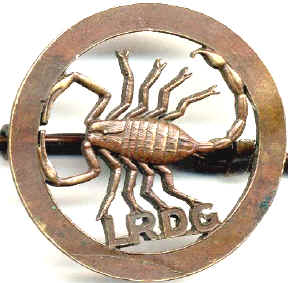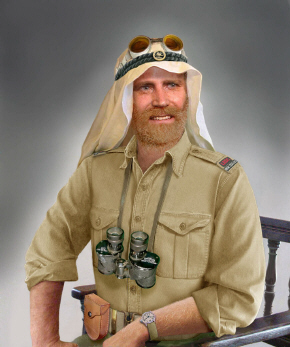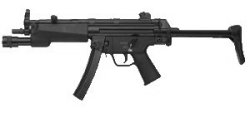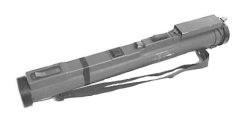|
Training in the Special
Air Service (SAS) units is considered to be some of the hardest in the
world. This can been seen in the fact that, unlike many
Special Forces whom are designed for specific operational areas, the
Special Air Service are trained in a multitude of areas. As a
result they are deployed in a great diversity of roles.
Counter-revolutionary Warfare (CRW), Airborne insertions, Maritime
roles, Reconnaissance, Indigenous recruitment and training, Combat
Search and Rescue (CSAR) and Hostage rescue.
The New Zealand Special
Air Service, and indeed other members of its Army, have a superb
reputation for producing some of the best combat Trackers in the world.
As a result Kiwi troops often teach these skills to the various US
Special Forces units and others around the world, including the British
SAS. Secondments to Australian and British SAS units, and other
Special Forces units around the globe ensure that New Zealand personnel
are well up with the play. It allows these forces and their
counterparts to gain invaluable experience and exchange ideas and
methods. World wide training gives realistic lessons in all types
of terrain conditions which is essential for operational competence.
The SAS is
open to any serving member of the New Zealand military; Navy, Air force or Army, of which most understandably hail from the Army.
Typically service of between two and four years is required before an
applicant is considered for selection.
In June 1955 it was
decided that the New Zealand Army required an elite unit capable of
specialist missions. Modeled on the British Special Air Service,
NZSAS was quickly seen to be both effective and professional. The
very arduous selection process, as then, only has a success rate of
approximately 10%. Even after being "badged", the probationary
period can see further applicants returned to their original units.
In April 1978 the 1st
Ranger Squadron became known as 1st SAS Squadron when the training
centre became self-contained unit. Previously based in Papakura
the unit looks to be returning there once again after being in
Hobsonville Airbase.
One third of the NZSAS
are on rotation with the Boat Troop who train in maritime skills
activities such as counter-terrorism, amphibious landings and beachhead
recce (reconnaissance). An integral part of SAS training is that
of airborne insertion and all methods thereof. Black Group is in
the role of Counter Terrorist Warfare (CTW). Alpine work on
mountainous terrain and use of explosives is taught to a high degree.
Linguist skills for specific operational requirements are taught as
required.
As New Zealand Defence
Forces have no Marine component the NZSAS are called on to be very
capable in maritime skills. This includes being able to make
landings on some of the roughest coastline in the world.
Security and need for
inconspicuous behaviour mean that while being aggressive is a small part
of some tasks a humble demeanor is required of SAS personnel.
Intelligence and initiative is a prerequisite in the SAS line of
work. As is patience, very long periods in a single spot
gathering intelligence is a good example of the need for this trait.
Organisation consists of
Two Squadrons of three troops each; Boat, Mountain and Air, and a
Headquarters element. It costs $39 Million a year to train these
elite Special Forces soldiers. Anyone who questions the need for
their capabilities and the budget would seriously need to ask themselves
that only until after they are dire need of their unique talents, making
a reassessment then. To this end about half the NZSAS total
personnel of the Special Warfare Group spend some six months a year
overseas. In recent years there has been talk about the New
Zealand Police taking over the role of Anti-terrorism.
This proposition is
considered extremely questionable by critics who use the Canadian
example as a case in point. Failure of the Police to effectively
perform Anti-terrorist roles brought about the formation of the current
Special Forces unit there, Joint Task Force Two (JTF2). Much of
the problem comes with the public perception were Police are in place to
enforce the law. The extreme circumstances which invoke counter
terrorist operations make this a difficult and complex condition indeed.
Many troubles, acts of
terrorism, attempted assassinations and military actions have been
avoided altogether simply through the knowledge of a small elite by
those that might have perpetrated such crimes. Even in the most
dire examples units like the NZSAS are one of the best deterrents on
hand.
The dagger has been
claimed
to represent the sword of King Arthur, Excalibur, but some others
suggest that it
represents the Sword of Damocles, while the wings (SAS exclusive design)
represent the airborne
nature of the unit. The universal Motto of the SAS units is
"Who Dares Wins".
Colonial
Times
Taranaki Bush Rangers
The first
Special Forces of New Zealand were raised during the Maori wars to
counter the Maori in the rugged bush country that was unique to the
country. The first of these forces was the Taranaki Bush
Rangers raised in 1863. They were charged with searching out Maori
war parties, acting as scouts and protecting the communications networks
of the English forces.
Forest Rangers
Though the
Taranaki Bush Rangers were a smaller unit of some 50 men, the Forest
Rangers was the first company sized unit, commanded by Major W. Jackson
in the same year. Later in 1863, Major G. F. Von Tempsky raised a
second company. The guerilla warfare tactics employed were
highly effective. These methods are still used today suitably
modified to work on the modern battlefield. The passing of the Armed
Constabulary Act of 1867 put an end to the Colonial Defence Force once
the fighting was essentially at a conclusion. The Special Forces
were disbanded on 22 October 1867.
World
War Two
 |
The Long
Range Desert Group (LRDG) was the direct parent of the SAS
concept and was charged with long range recce and raiding missions
against the Germans and Italians in North Africa during the Second
World War.
Started by David Sterling, the
unit was originally called Detachment L, to be renamed 1st Special
Air Service Regiment in 1942. The founder was recovering
from a parachuting accident at the time.
New Zealanders played a major
role in the LRDG and this was recognised by their being referred to
as the Kiwi Scorpions', with the Scorpion being the symbol of the
LRDG. |
| The unit
grew until there were several other Allied components, including French
and Belgian. From the outset the founding unit was given the motto
"Who Dares Wins" which has stood to this day.
Raids were typically performed with Jeeps carrying extra water and fuel
for long range missions and armed to the teeth with Vickers K
machineguns, Lewis guns.
By the end of the North African campaign
the SAS had destroyed over 400 enemy aircraft. The SAS Brigade as
a whole inflicted more than twenty times as many casualties as they
suffered in the operations of 1944/45.
They took about 5000 German
prisoners. |
 |
Malaya
and Borneo
In 1956
the NZSAS Squadron was attached to the British SAS in Malaya. It
fought against Malaysian Communists with great success. Asides
fighting these guerrilla forces they were also charged with collecting
up and training villagers to fight as well, in a similar fashion as US
Green Berets did during Vietnam. In over a dozen major engagements
only one NZSAS trooper was killed. Soon after the unit was
disbanded, having been operationally replaced by an Infantry Battalion.
Still, it did not take long for the SAS unit to be reformed.
The NZSAS
also had the job of countering Indonesian Communist insurgents in
Borneo. Here in the harsh jungle environments the Kiwis' tracking
skills were called upon. British and Australian forces were
also involved in this conflict. "Hearts and Minds" operations
were very effective here and a major element of Special Forces
operations.
Vietnam
Based in
Nui Dat in Vietnam the New Zealand Special Air Service 4th Platoon
served under Australian command in November 1968, attached to the
Australian SAS Regiment. Each tour was of a year's duration
and included several platoons' involvement. Here NZSAS was named
1st Ranger Squadron. Most tasks involved ambush of enemy forces
and doing recce missions observing the enemy. NZSAS also worked in
conjunction with US Army Special Forces. Previous experiences in
Malaya and Borneo stood the unit in good stead for the jungle
environment.
Recent
Times
Currently
troopers of the NZSAS are deployed in Afghanistan where their skills in
tracking are being used to good effect in hunting down members of the Al
Qaeda terrorist network. The US has always been keen for New Zealand
support in the past and the current War on Terrorism is no exception.
New Zealand SAS soldiers have had extensive experience in the Middle
East including fighting Islamic fundamentalist groups at the invitation
of the Sheik of Oman. Missions in various capacities have existed in a
on going fashion since the 70's, through to the Gulf War and to the
present day.
More
recently, A 'clash' with Abu Sayaff in the Philippines ended in another
successful contact for the NZSAS. Currently NZSAS personnel are working
alongside Australian SASR soldiers in the Anzac tradition. It can be
deduced they are also working alongside their US counterparts, though,
like in Vietnam most operations will be independent, and in smaller
units. The 30 men of NZSAS are being provided logistical support from
two RNZAF C130 Hercules'.
Undoubtedly
as history has shown tasks will include training of local Anti-Taliban
Afghan forces, deep reconnaissance and, where required, offensive
operations. Operating in traditionally small units of no more than five
men the NZSAS has been operating covertly at very high altitudes, above
Al Qaeda positions. They have been guiding in the 1500 Allied troops
involved in 'Operation Anaconda'.
Equipment
As is
common with world Special Forces in general, the NZSAS is no exception
to the rule of having access to most tools of the trade. Getting
to play with the fancy gear is an advantage of such service but when it
comes down to it New Zealand prides itself in the concept that the man
makes the gear not the other way around. Scopes and other
added features are often included in weapons load-outs for increased
effectiveness. Unlike regular units, the NZSAS member is permitted
a certain amount of personal choice and flexibility in their kit.
 |
M16A2
The US manufactured M16 Rifle is popular with the NZSAS as it is
with other SAS units around the world. The Steyr AUG is the
New Zealand Army standard issue rifle and this is also seen in
service depending on requirements. The older M16A1 with its
fully automatic sear is also used. |
| Due
to history this rifle, regardless of generation is referred to as
the Armalite.
The severely cut down version, the Colt Commando has also seen
use, as has the more recent M4 Carbine. One weapon
appreciated for its power is the SLR Battle Rifle, on issue to the
New Zealand Army before the Steyr, alongside the M16. |
 |
Silenced
Sterling SMG (L34A1) This
is the silenced version of the very famous British Sterling SMG.
It is very quiet and very robust. Though a bulky weapon
compared to modern designs it is very reliable and still has a
place in the NZSAS armoury for its very specialised role. |
| Primarily
the L34 is intended for eliminating personnel targets when stealth
is of the utmost importance. This helps a covert force avoid
detection and also avoids unwanted hostile encounters. The L34 was
used by the British Royal Marines own Special Forces, the Special
Boat Squadron (SBS) during the Falklands. |
 |
HK
MP5 The very popular MP5
sub-machinegun design from Germany is used in many operational
capacities and is liked by many of the world's Special Forces for
its extreme accuracy. The NZSAS is no exception. |
| Different
configurations allow for different needs, including the MP5K,
which is particularly compact and able to be carried concealed for
the VIP Bodyguard role. A suppressed version is present also. The
9mm pistol ammunition the MP5 uses makes it ideal for counter
terrorism work where a will aimed burst is still lethal while not
presenting a danger by penetrating walls and other structures,
thereby having the potential to injure non-combatants. |
 |
C9
Minimi Known in other
services as the Minimi or C9 this Light Machinegun, designed in
Belgium is used by many forces around the world. Using the same
small round as the M16 makes for good logistic sense and also
other than the standard belt (held in a plastic box) of 200 rounds
the weapon also accepts M16 magazines. |
| A
gunner may carry a few such magazines for an emergency. With a
range of 600 metres and capable of sustained fire rates the weapon
is a good accurate one for the modern battlefield. |
 |
M203
40mm Grenade Launcher The
M203 is attached to the bottom of the M16 rifle. This
40mm grenade launcher gives the SAS unit, considering its
typically small size, very formidable firepower. |
| Various
ammunition types allow for tactical flexibility, including; high
explosive (HE), smoke and buckshot (which works like a shotgun on
steroids). Less than lethal ammunition such as Tear Gas (CS) can
also be fired from these weapons for riot control or seizure of
criminals. A major task for the NZSAS is recce work and this
weapon gives the unit the capability to counter-attack very
effectively if they are compromised. But all efforts
are made to insure the need is not required with first rate field-craft.
The M203 below is mounted on the M4 Carbine, a cut down version of
the M16A2. |
 |
M72
LAW (Light Anti-tank Weapon) The
M72 is a single shot, disposable anti-armour weapon.
With the advent of more
effective armoured vehicles the 66mm HEAT round is much less
effective than it once was for its original intended role. |
| But
still, the M72 is very effective in the bunker buster and
anti-personal role and against lighter armoured vehicles.
Once fired the left over tube is discarded, or carried out if
operationally required. Either way each launcher including
its integral rocket is very light. |
NOTES
:
The NZSAS
are trained in the use of many other weapons for complete battlefield
adaptability including mortars and Anti-tank weapons such as the 84mm
Carl Gustav. Sniper rifles and other firearms are used for various
tactical roles. Experts in Close Quarter Battle (CQB), the
SAS are trained to a very high degree in the use of pistols, the
Browning High Power and Sig Sauer P226 are typical examples.
Claymore mines for Anti-personnel work and constructing hasty ambushes
are used, as are shotguns in close jungle and bush country.
Foreign weapons are taught to ensure competency in an operational
situation should the need arise to utilize them.
Training
The
selection process is 14 days long. Pre-selection ensures that those
wanting to take on the challenge have the necessary navigation skills
required to even attempt SAS selection. Even on passing one of the
world's hardest tests to enter one of the world's most elite of the
Special Forces there is still a further 9 months of training, learning,
taking in so much more information. Failure at any stage means
being returned to their original unit.
Inside of
two weeks two thirds of candidates are typically eliminated from the
selection process. It is evident that the training is as much
about mental toughness as it is physical, the need to carry on well
beyond what you would physically be able to manage. This ensures
that, operationally the SAS trooper can manage beyond the limits of
conventional forces on tasks which call on very special people in the
most arduous of conditions working in very small teams. Often
there is no support.
Navigating
over hard Waikato farmland at night is a key feature of the selection
process, having to make it to key map references. This must be
done at an average of 3 kilometers an hour. To be too slow means
you're out. All this on limited food intake. All part
of testing endurance and determination while partaking in these solo
efforts.
The Jerry
Can test finds the candidates carrying a 25kg Jerry Can filled to the
brim over the Kaipara sand dunes. There is always an extra can
which has each candidate taking turns to carry two at once.
Despite
making good times and performing well some simply give it away, deciding
that the SAS is not what they want. A great deal of the difficulty
comes from not knowing when a given exercise is going to end. You
must carry on regardless, if you want to make it.
Surviving
candidates are thrown head first into a Escape and Evasion test where
SAS staff hunt them down relentlessly. This tests the resolve of
the men to their limits and beyond. "Hare and Hound" is
relegated within a specific area and if the candidate is caught outside
that area, they are put back 10 kilometres. Because this test must
be competed within a given time, including navigating through very dense
forest, no one wants to go outside the set boundary. Pure
exhaustion might inadvertently lead to that anyway.
To finish
there is a 60km trek through Woodhall Forest, reputed to be the hardest
part of the whole ordeal. Even after completion some who have made
it to the end are not selected. They are deemed to immature or do
not fit the psychological profile required. Once badged the NZSAS
trooper wears the coveted sand beret, like that of the as that of the
British SAS or Australian SASR. This has only been instituted
since around 1986, where previously, rather than the sand coloured
beret, the red beret with SAS badge was worn. This is significant in New
Zealand where there is no Airborne unit, which, traditionally world wide
airborne personnel wear the red beret.
Text from  by Leon T. Harrison
by Leon T. Harrison |